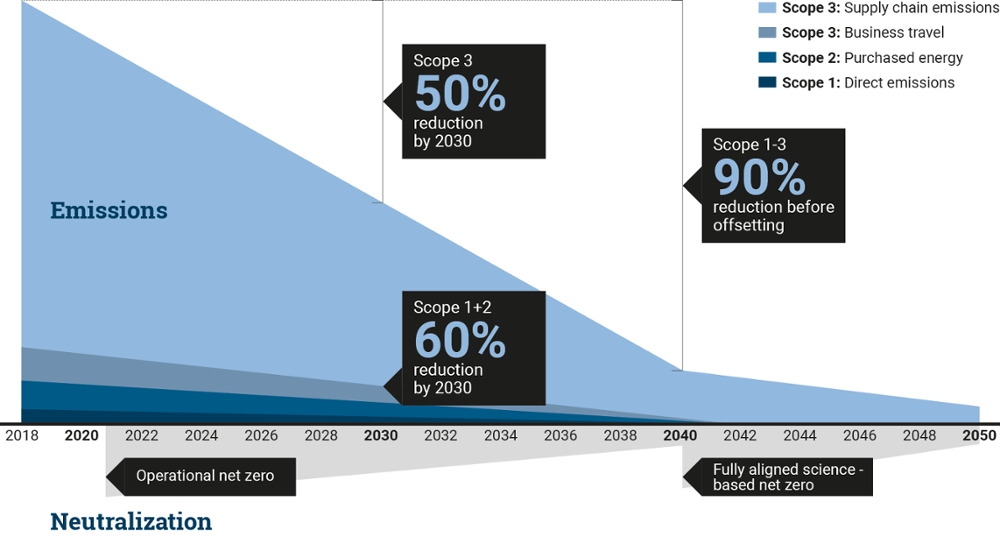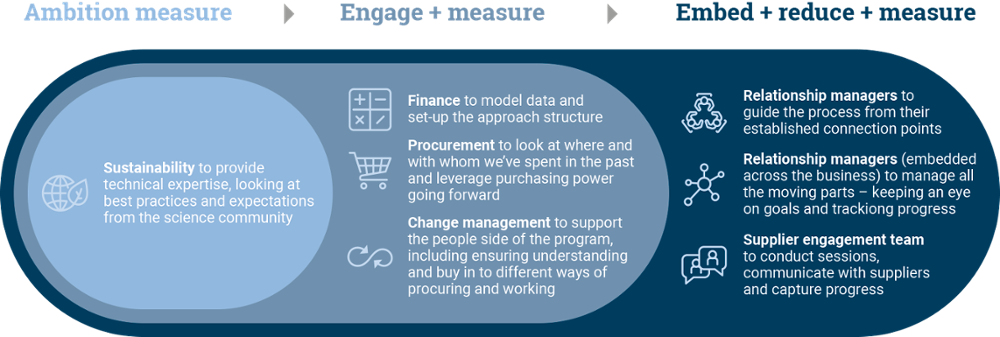
In this chapter of Environment Analyst's Corporate Guide: Accelerating your ESG transition, Robert Spencer, global lead, ESG advisory, and Ryan Burrows, sustainability manager, at AECOM, outline how to address the scope three challenge.
Introduction
Scope 3 represents industry’s single greatest opportunity to make a significant reduction in our greenhouse gas (ghg) emissions.
Scope 3 emissions are defined as all indirect emissions that occur in the value chain of the company. Emissions associated with work travel, employee commuting, purchased goods and services and waste management all fall under scope 3.
Therefore, one company’s scope 3 emissions are another’s scope 1 and scope 2 emissions. Taking on the task of scope 3 emissions reduction is therefore a challenging but essential step in reaching science-based net-zero targets.
Large firms like AECOM can use their scale and breadth in the environmental, social and governance (ESG) space to collaboratively accelerate industry progress to that end.
Why focus on scope 3?
The Science-based Targets initiative (SBTi) net-zero standard requires scope 3 targets for any company for which scope 3 makes up more than 40% of its total scopes 1, 2 and 3 emissions.
By addressing emissions together, we help our planet and all those who live on it. We unlock innovation and efficiencies in products and services and enable broader conversations around ESG. We also create a forum to identify business areas with the greatest climate risk and thereby collectively anticipate potential market and regulatory impacts.
At AECOM, 96% of emissions reside in our supply chain. As such, we have set bold carbon reduction targets and have to date lowered our scope 3 emissions by 8% against our 2018 baseline.
We are a large organisation with established systems in place and are fortunate to have a dedicated carbon team. We see our role as early navigators, with a responsibility to share experiences and information that will aid in decarbonising our industry by helping to save cost, time and effort for those following in our footsteps. Some of these experiences are outlined here.
There are fifteen categories that make up scope 3, according to the ghg protocol standard. One is the use of Sold Products, which is significant for many companies, but does not apply directly to us. As a design consultancy though, there is a significant amount of embodied carbon in the materials (notably steel and concrete) used to construct our infrastructure projects. We have developed what we call our Scope XTM approach, which enables us to bring together processes, frameworks, methods, skills data and digital tools to reduce carbon at every phase of our design and construction process.
In this chapter, we focus on where the bulk of our emissions lie and where our efforts will have the greatest impact, which is through purchased goods and services in our supply chain. Without direct operational control, influencing change means working closely with our partners, step by step, to collectively reduce emissions.
Starting the supplier engagement journey
Our expertise enables us to help other organisations better understand their ghg emissions, provide training on carbon assessments, and offer strategic advice and practical solutions to help decarbonise their operations.
We recognise that telling others to invest in gathering detailed scope 3 emissions data because "it’s the right thing to do" is not always sufficient. Suppliers are likely to receive requests from several clients at different times, through different systems. This can be overwhelming for them to field while managing their own business operations. We need to be clear that any changes to the way they operate or additional requests from us will add value for them. By sharing our own experience and showing results, we aim to motivate and inspire our partners to join us on the journey to net-zero.

Climate transition place (source: AECOM)
In it for the long-haul
Onboarding a supplier and supporting them until they reach net-zero will be a lengthy and involved process. A significant amount of time and diligent follow-up needs to be allocated to identifying the appropriate ESG contact(s) at each organisation and then planning, segmenting and scheduling initial briefing sessions. It took AECOM a few months to adequately map our process, but the upfront planning time has paid off in the form of sustained engagement with our suppliers.
Drawing an immediate hard line in your procurement processes may be tempting as a faster and less labour intensive way to reduce scope 3 emissions, but be aware – that approach does not take social equity into consideration. Some companies are pressing ahead with their efforts, but there are several factors — including different regional regulatory environments, knowledge, and capacity — that may be speeding or slowing the efforts of others.
We give particular attention to small- and medium-sized enterprises (SMEs) that may not be able to justify allocating significant resources to decarbonisation, scope 3 data reporting or ESG in general. Greenhouse gas (ghg) accounting can be challenging to learn and even more challenging to properly execute. Rather than leaving them behind, we are transparent about our ambitions and expectations, offering dedicated support to help them move forward with us. As part of our phased approach, over time, we will increasingly work with suppliers whose ESG goals are aligned with ours.
It’s all about the people
It’s important to keep in mind that most suppliers have likely not yet begun this process, and while many appear open and receptive, others will need more encouragement to arrive at the starting line. To make sure they stay engaged, their concerns need to be heard and taken on board. We have found that the most effective way to manage this engagement is at the individual level. Procurement processes and compliance requirements are all necessary components of the scope 3 supplier engagement journey, but people really drive relationships and our buyers most often already have that established personal connection with suppliers.
Depending on the size of your organisation, the thought of speaking to every supplier individually may be daunting. We found success in starting with an initial, broader briefing webinar and then individual conversations around scope 3 with our high priority cohort of suppliers — which make up 50% of our emissions per region — before moving to our medium priority cohort, comprising the next 20%. Generally, once we’ve identified the appropriate decision-maker in any supplier company, we assess where that supplier is on their journey, meet them there on a personal level, and stay with them throughout.
Building a winning team
Initial progress with scope 3 hinges on setting up the right internal team and aligning on key priorities and consistent messaging. The group needs to be able to work together to understand the data and engage suppliers from multiple angles, including leveraging team members who have existing, trusted relationships with suppliers.
Bringing together a diverse group of stakeholders from several relevant internal departments — considering regional variation and cross-cultural representation — is vital. We’ve started to require existing functional teams to become carbon literate and eventually we’ll look for new hires to be equipped with skills and experience in this space as well.
Taking a snapshot of a well-balanced team in our organisation, it is likely to include members with the following backgrounds and areas of expertise:

Embedding sustainability within organisation team structure (source: AECOM)
Some level of dedicated oversight for your team – at least at the top level – is ideal. This can be a challenge when leaders in your organisation already have their own roles and responsibilities, but it will help ensure consistency and accountability. We found it helpful to report progress to leadership, including the percentage of our supply chain engaged, on a quarterly basis.
Data: perfection must not be the enemy of progress
GHG data improvement is an ongoing and long-term initiative. Given that very few organisations are reporting on scope 3 emissions yet, the lack of available data is a challenge at this early stage. Of the figures that are reported, there are concerns around quality and accuracy as a result. The data is complicated, wide-ranging and specific to each industry. Yet, we must begin somewhere and our recommendation is to dive in and then assess gaps in existing data collection and analysis practices.
The challenge, then, is that if we don’t have raw emissions data from the vendor, we must calculate it based on activity data. Initially, organisations will be working off spend, which is the most accessible form of activity data — and the type that AECOM is currently using. The goal is to continue collecting data and eventually to decouple spend from carbon emissions to obtain a more accurate picture.
As an example, in the beginning you may be recording all suppliers from a given sector in the same way in terms of their carbon intensity per dollar spent. The next evolution will be to get real data directly from those vendors, at a corporate level. As you get more granular data from them on the services or products they provide, you can assess which suppliers, services and products have the lowest carbon footprint and use that information to help bring down your
scope 3 emissions.
There will inevitably be errors in the beginning, but the question for us all must be – are they material? There is an element of acceptance needed to recognise that, even with some level of inaccuracy, the rough picture presented is valuable. We can work to identify and fill data gaps, while simultaneously moving forward and having conversations with suppliers. Consideration of materiality is also a key element of our annual third party verification process.
The road ahead: developing best practice using digital processes and tools
The most effective approach to structure and streamline scope 3 data management, collecting and reporting conveniently follows best practices that apply across scopes 1, 2 and 3. Here are our recommendations for how best to get started, based on the work we provide for clients.
(i) Strategy before tactics
Start with a sound digital strategy. Tools, software and gadgets can come later. Define what you want to do for scope 3 and define the reporting structure, including elements that are particularly relevant to your industry vertical.
(ii) Start with what you already have
Identify the data that is already being collected for scope 3 and establish where the gaps are. Leverage and integrate existing technologies, platforms and touchpoints — including those with suppliers.
(iii) Getting to insight
Select and/or develop tools that will help to make data collection more efficient. Build a data management strategy that uses smart integration, rather than 1:1 integration. Leverage the latest in data lake construction, analytics and decision support to move beyond getting information and instead gaining insight.
For clients who have already begun scope 3 data collection, the biggest request we get is to help them automate the process. To get them to a more structured approach, data improvement is key. We define their objectives and reporting structure based on their industry, identify their collection gaps and then develop a tailored tool that helps make the collection process more efficient. Eventually this will decrease the time, effort and room for error currently involved in data collection and lower the barrier to entry for more resource-constrained organisations.
Conclusion: the journey begins with a single step
In addition to helping achieve related goals such as increased efficiency, approaching scope 3 has the potential to spark tremendous innovation and collaboration across the entire value chain. Leading by example, connecting on a personal level, choosing the right people for your team and diving into
the data are all tried and tested measures for successfully starting to engage your supply chain.
Above all, don’t let the length of the journey or the complexity of the task at hand discourage you from getting started. For us, the passion and steadfast commitment of our global sustainability team is critical to achieve results. If we can collectively stay the course, the progress will be well worth the effort.
—
This chapter of Environment Analyst's Corporate Guide: Accelerating your ESG transition was kindly authored by Robert Spencer, global lead, ESG advisory, and Ryan Burrows, sustainability manager, at AECOM. The full Corporate Guide contains chapters exploring stretch targets, TNFD and nature-based reporting, legislative risks, moving to meaningful ESG impact and more. To download the full guide click here.
